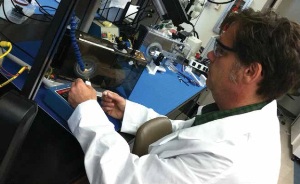Nov 29 2013
Thirty thousand Americans suffer severe neurological damage or death from brain aneurysms each year and the existing treatments eventually fail in nearly half of patients. Currently, these “bubbles” in the blood vessel are either clamped off, which requires invasive brain surgery, or filled with platinum coils to induce clotting in the aneurysm.
 Dr. Duncan Maitland works with shape memory polymer foam at Texas A&M. Source: Duncan Maitland, Texas A&M
Dr. Duncan Maitland works with shape memory polymer foam at Texas A&M. Source: Duncan Maitland, Texas A&M
Both treatments, although somewhat effective, can have subsequent problems, including inflammation, incomplete healing, and the development of secondary aneurysms adjacent to the initial site. These complications result in approximately 40 percent of patients needing additional treatment to attempt to re-repair the aneurysm.1
NIBIB-funded researchers in Texas A&M’s bioengineering department are moving rapidly to provide a better treatment for this serious disorder. The group specializes in using the unique properties of foam shape memory polymers (SMPs) to solve clinical conditions lacking satisfactory treatments.
The group, led by Associate Professor Duncan Maitland, is using SMPs in a pig model of brain aneurysm to develop a minimally-invasive procedure that fills and stabilizes the aneurysm. Because the system induces only minimal inflammation, it successfully allows natural healing of the border between the aneurysm and the blood vessel. As reported in the May 22 issue of the Journal of Biomedical Materials Research, partial healing was observed at 30 days post-procedure and almost complete healing had occurred at 90 days in the pig model.2
How it Works
Two of the properties of SMP are critical to the success seen in the animal experiments:
- the foam’s ability to be compressed into a very thin sheath and then induced to expand to 100 times its compressed volume when heated, and
- its rigid, yet porous structure when fully expanded.
The rigid uniform structure of the expanded foam is a significant improvement over the current practice of filling an aneurysm with a platinum coil. Because a coil is threaded into the aneurysm until it fills the space, pressure is exerted on the aneurysm during the process, which can damage the vessel wall. In addition, the platinum coils do not uniformly fill the space, leaving large gaps that can allow shifting of the coils as well as the formation of unstable, large clots. The platinum coil approach can also result in inflammation which destabilizes the aneurysm, resulting in incomplete healing and failure to completely wall-off from the blood vessel.
The minimally-invasive procedure involves inserting the slim, compressed foam into the aneurysm using a microcatheter. The microcatheter is inserted into an artery through a small cut in the groin and then threaded through the blood vessels to the location of the aneurysm in the brain. Once in position, a laser optical fiber heats the foam to induce expansion and complete filling of the fragile pouch of the aneurysm. In contrast to the platinum coils currently in use, the foam exerts a firm, uniform pressure on the walls of the aneurysm, which reduces chances of rupture.
The foam contains tiny compartments that result in the development of a matrix of blood clots that further stabilize the structure. The investigators found that unlike the aneurysms filled with metal coils, the foam structure produced little inflammation and allowed natural healing, defined by the growth of new cells at the border between the foam and the wall of the damaged blood vessel.
Making a Difference through Innovative Technologies
Dr. Maitland describes his work, broadly, as developing technologies to solve clinical problems that lack satisfactory solutions. He has formed a company called Shape Memory Therapeutics to assist with moving the encouraging results obtained with the SMP system from animal models into testing and, potentially, eventual use in humans. Maitland’s desire to make a difference is clear. “There are people walking around with aneurysms that are untreatable. My hope is to develop a game-changing therapy that reduces the risk of aneurysm ruptures, increases patient safety, and has a real impact on human health care.”